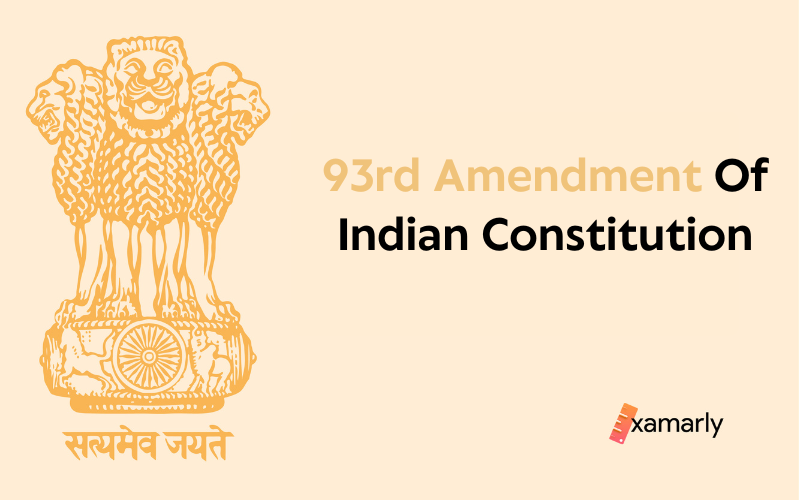The 93rd Amendment of Indian constitution adjoined a clause to Article 15 stating that the state has the authority to establish certain specific Provisions concerning accommodations for the progress of any sociologically and academically disadvantaged sectors of the society, as well as to the scheduled castes and scheduled tribes, with respect to their enrollment to academic institutions, including private academic institutions, whether assisted or unassisted by the state, except minority institutions.
- Salient Features And Facts of 93rd Amendment Of Indian constitution
- Date Enacted
- Statement of Objects and Reasons
- Prominent People Involved
- Important Provisions Under 93rd Amendment Of Indian constitution
- Cases Involving The 93rd Constitutional Amendment
- Supreme Court remarks On The 93rd Constitutional Amendment
- Summing Up
- FAQ's
- What had happened to Article 15 before the 93rd amendment of Indian constitution was passed in 2005?
- How will the court determine if a specific provision of the Constitution is a portion of its fundamental design or not?
- Which constitutional amendment is connected to the issue of reservations for Weaker sections in private educational institutions?
- Which Amendment of the Indian Constitution grants admission rights to students of weaker sections of society into private education institutes?
Salient Features And Facts of 93rd Amendment Of Indian constitution
Some important features and facts related to the 93rd amendment are as given below :
- Article 46 of the Indian Constitution grants the state government the power to help the economic security and educational disparities of the poor and defend them against social and economic injustice.
- The court in the case of Islamic Academy v. the State of Kerala determined that the state government lacks the authority to control tuition costs and that educational institutions may only admit students based on their performance in Common admission exams.
- The government lacks the right to enforce its reservation policy on privately funded organisations that serve both minorities and non-minorities, particularly professional colleges, according to the court’s rulings in T M A Pai Foundation v. the State of Karnataka, (2002), and P A Inamdar v. the State of Maharashtra, (2005). In these judgments, the Supreme Court rejected the idea of reserving places at academic institutions without government support for minorities or non-minorities, contending that doing so would go against their fundamental right to liberty. This goes beyond the acceptable restrictions outlined in Article 19 and would violate their rights under Article 19(1)(g). (6).
- Article15(4), which addresses academic growth but omits the phrase “admission to educational institutions,” was established by the 1st Amendment of the Indian Constitution in 1951. The Constitution (Ninety-Third Amendment) Act, 2005 was passed by Parliament in 2006 to assist the educational objectives of the underprivileged sections of the nation and to bring private colleges and unaided education institutions under the government’s reservation policy. The government’s ability to set exemplary provisions is expanded by this change.
- Article 15(5) of the 93rd Amendment of Indian constitution concerns “admission to educational institutions.” The scope of the modified Act is considerably widened by adding clause 5 to Article 15. This grants union and state legislators the power to pass legislation relating to reservations.
- The government proposed the reservation in the admission Act, which was approved by the Union Parliament in 2006 as a consequence of the 93rd Amendment Act.
Date Enacted
The 93rd amendment of Indian constitution was passed nearly unanimously in Parliament in December 2005
Statement of Objects and Reasons
- It has long been a primary priority to provide more students from Scheduled Castes and Scheduled Tribes, as well as students from socially and educationally disadvantaged sections of citizens, with access to higher education, particularly professional education. Currently, there are fewer seats available in assisted or State-maintained colleges than in privately run institutions, especially when it comes to professional education.
- According to Article 46, the State is required to protect minorities against social injustice while also advancing their economic and educational interests.
- It is suggested that article 15 be expanded in order to encourage the academic progress of the socially and academically underprivileged groups of people or of the Scheduled Castes and Scheduled Tribes in matters concerning to admission of students pertaining to such groups in unassisted educational institutions, besides the minority academic institutions listed in clause (1) of article 30 of the Constitution.
Related – 65th Amendment Of Indian Constitution
See Also – The Scheduled Castes And Scheduled Tribes Orders (Amendment) Act, 1956
Prominent People Involved
Arjun Singh, the then UPA HRD Minister, presented the bill in the Indian Parliament.
Important Provisions Under 93rd Amendment Of Indian constitution
The following provisions were established by the Central Educational Institutions (Reservation in Admission) Act, which was passed by the Parliament in 2006:
In relation to Seat Reservations in Central Academic Institutions:
- 15% of the annual approved quota in each department or field of study shall go to the people belonging to Scheduled Castes.
- 5% of the seats will go to scheduled tribes,
- The remaining underprivileged classes should be guaranteed 27% of the seats.
The Act does not apply to:
- An institution of higher learning with its main campus located in a tribal territory as defined by the Sixth Schedule of the Indian Constitution;
- A Minority educational Institution.
Cases Involving The 93rd Constitutional Amendment
- The court upheld the caste-based backwardness standards in P. Rajendran v. the State of Madras. According to the Court, if the reservation was made today purely based on caste and had not taken into account socioeconomic and educational backwardness, it would have violated Article 15(1). According to Articles15(4) and15(5) of the Indian Constitution, a caste’s members can only receive reservations if they are deemed to be socially and educationally backwards.
- In Haryana Progressive Schools Conference v. Union of India, the Hon. Supreme Court recognised that the power granted by Article 15’s clause (5) is a directed power that must be used for the few restrictions listed in the provision. It further said that laws passed by the government in the course of its authority under Article 15’s clause (5) must be put into effect for the reason stated in the provision.
- The Court ought to examine and establish if it serves the betterment of the socially and educationally disadvantaged sections of people or for the SCs and STs, and if the statute is limited to allowing admission of Scheduled Castes and Scheduled Tribes to private colleges, irrespective of if they receive government help.
- The legislation must be deemed supra vires under Article 19(1)(g) of the Indian Constitution if the court determines that the authority was not utilized for the purposes specified in clause (5) of Article 15 of the constitution.
Implications Of The 93rd Constitutional Amendment
- This law was passed to fulfil the constitutional requirement to empower the underprivileged classes.
- It “clearly contradicts the essence of equality embedded in the Constitution by eliminating educational institutions formed by minorities and subjecting non-minority established institutions to bear the weight of weaker Sections that are less worthy,” claim the opponents.
- Article 15 (5)’s exclusion of minority institutes conflicts with Article 15 (4)
- No conflicts to eliminate educational gaps among BCs.
- Former HRD Minister Arjun Singh referred to this Act as “enabling legislation,” which implies that it is sneaky and enables the government to impose reservations throughout the board, from early childhood programmes up to higher education institutions.
- The term “admission to educational institutions” is specifically included in the 93rd Amendment, broadening the extent of its application. today The term “admission to educational institutions” is not used in this particular amendment; it refers to “educational advancement.” Therefore, the amendment act’s reach has been greatly expanded as a result.
Supreme Court remarks On The 93rd Constitutional Amendment
- The Supreme Court affirmed the rule establishing a 27% quota for applicants from OBC in Central higher education institutions.
- It instructed the government to keep the “creamy layer” of OBCs out of the law’s implementation.
- By stating that minority educational institutions are a Separate class and have other constitutional protections for their rights, it concludes that Article 15(5) does not apply to them.
- The CJI claims that, insofar as State-maintained institutions and publicly funded educational institutions are concerned, the 93rd Amendment Of Indian constitution does not go against the fundamental principles of the Constitution. The Constitution’s Article 15(5) is legitimate under the law, and Articles 15(4) and 15(5) do not conflict with one another.
What Are The Arguments Against The 93rd Constitutional Amendment?
- Consequence of the modification, which limits their ability to enroll in higher education institutions, it annoys certain students from the general category.
- Reservation policies go against the idea of equality. Equal protection and rights for everyone are necessary for equality. But the equality doctrine is violated when certain categories of people are given special consideration and protection. It contradicts the core tenets of democracy.
- The admissions process’ effectiveness and meritocracy are undercut by the admissions reservations. Because competent and intelligent people are not given their fair share of admissions, private educational institutions must make quality compromises.
- The Constitution omits defining what the “backward classes” are. Even though Article 340 permits the assembling of a board to assess “socially and educationally backward classes,” there is no widely accepted process.
- The amendment mentions reservation policy as the primary cause of class-based politics for votes in the country’s political system. Caste distinction is being overemphasised, which is preventing national unity. The populace also claims that castes have been utilised to protect the voter bases of different political parties.
Summing Up
The government of India to advance the nation’s socially and economically underprivileged strata through the 93rd Amendment of Indian constitution of 2005. An enabling clause to Article 15 is Article 15 (5), which aims to promote the growth of Weaker Sections of Society and to give societal interests precedence over those of individuals or groups who have made significant strides in their social and academic development.
FAQ’s
What had happened to Article 15 before the 93rd amendment of Indian constitution was passed in 2005?
According to Article 15 of the Indian Constitution, no one may be subjected to discrimination on the grounds of their birthplace, gender, race, caste, or religion. However, Article 15(4) specifies that the state may adopt specific guidelines for the advancement of Scheduled Castes and Scheduled Tribes, as well as other socially and educationally underprivileged segments of the population. All government organizations have effectively embraced this reservation system. A dispute arose regarding reservations at for-profit educational institutions, albeit it was later resolved by the 93rd Constitutional Amendment Act.
How will the court determine if a specific provision of the Constitution is a portion of its fundamental design or not?
It should be assessed within every unique circumstance while taking into account the Constitution’s Directive principles, goals, and intentions, as well as the Constitution’s credibility as the cornerstone of the nation’s administration. Its basic structure hypothesis would only be broken by an amendment that creates a circumstance that is not properly covered by any concept of equality.
Which constitutional amendment is connected to the issue of reservations for Weaker sections in private educational institutions?
93rd Amendment of Indian constitution saw the passage of the amendment. In this, seats have been set aside for the admission of members of the scheduled castes, tribes, and other backward sections in educational institutions.
Which Amendment of the Indian Constitution grants admission rights to students of weaker sections of society into private education institutes?
93rd Constitutional Amendment grants admission rights to those hailing from weaker sections of society into private education institutes.






